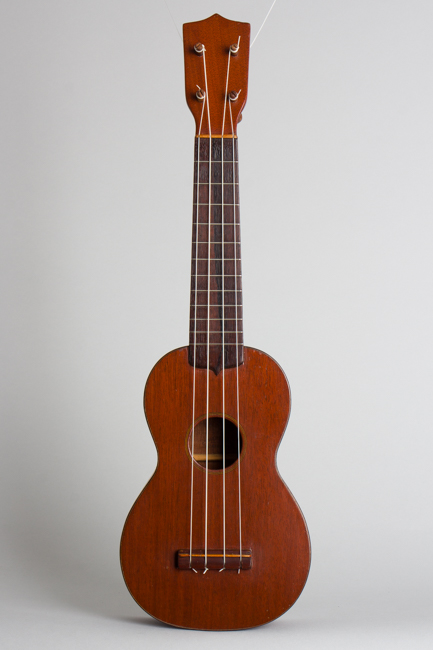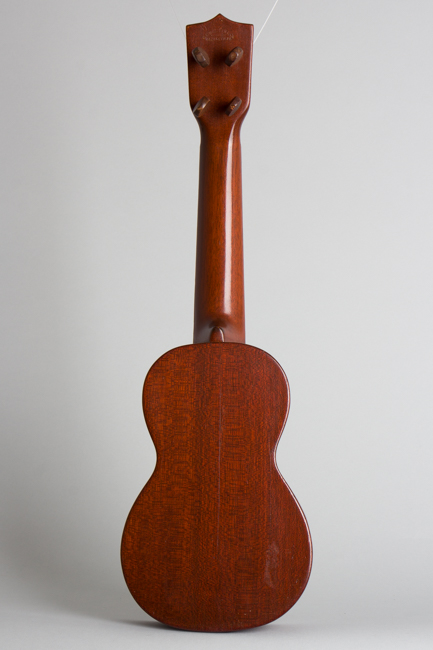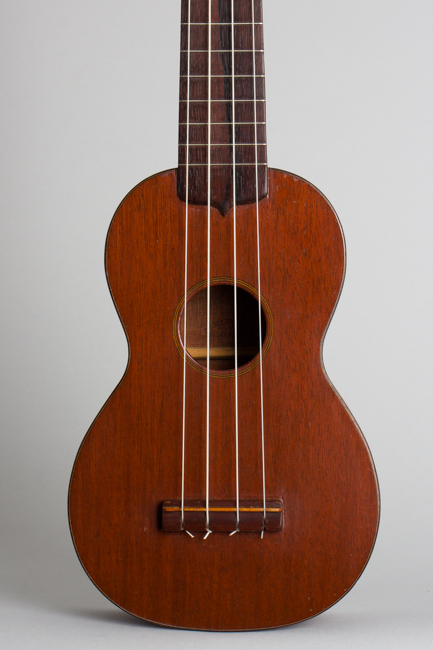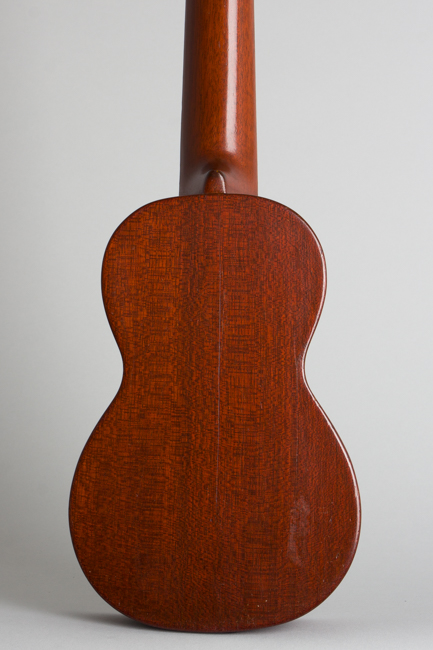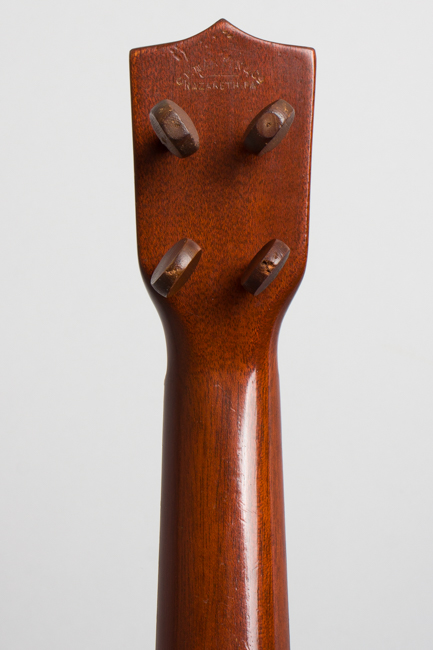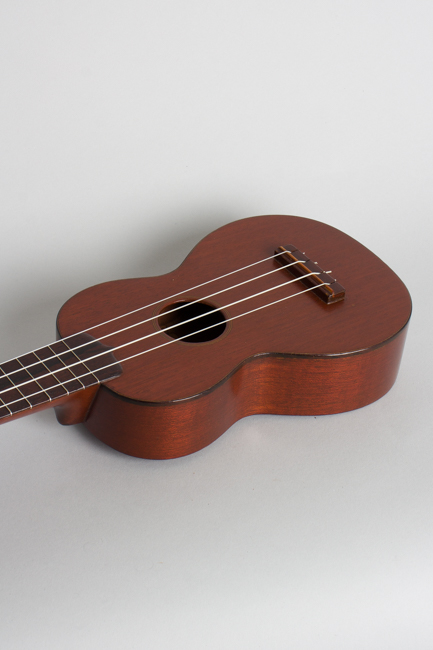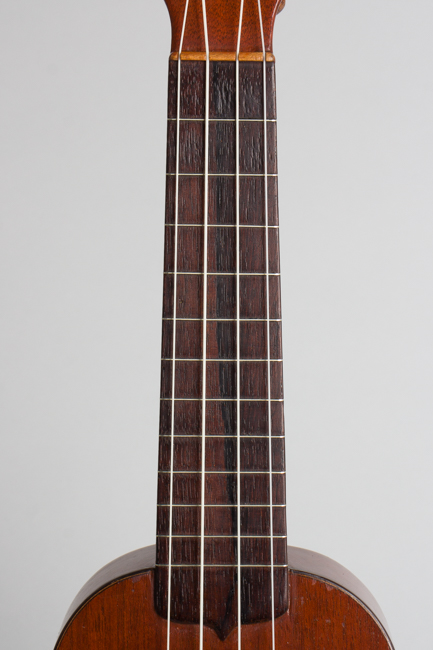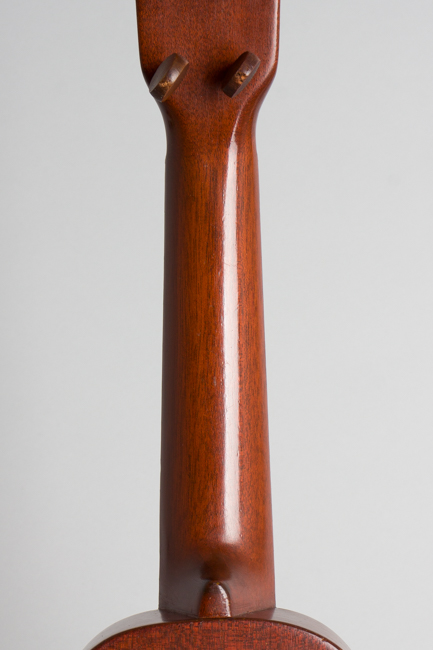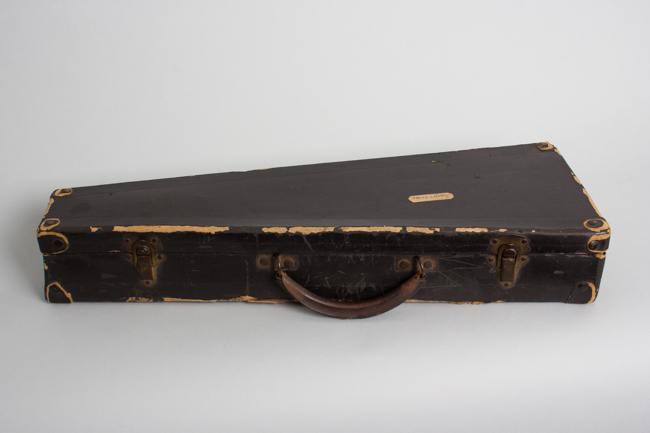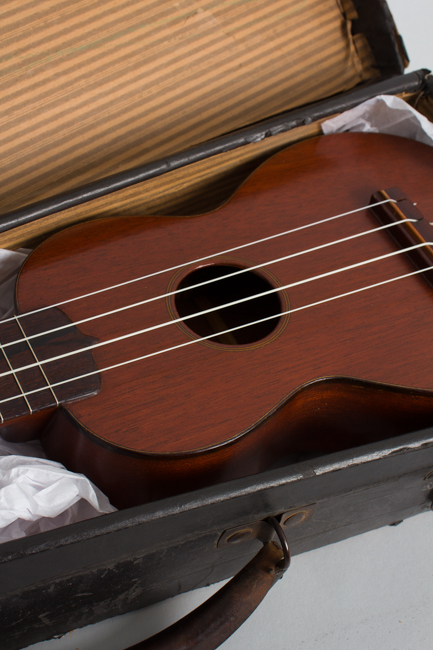C. F. Martin Style 1 Soprano Ukulele (1916)
C. F. Martin Style 1 Model Soprano Ukulele (1916), made in Nazareth, PA, dark mahogany finish, mahogany body and neck, rosewood fingerboard, black period chipboard case.
This is a lovely original example of a VERY early Martin Style 1 ukulele, from the first year or so of production. Although by Martin standards these were an inexpensive instrument (originally retailing in the $12 range), they are built to the highest Martin standard and are still considered easily amongst the best-sounding ukuleles ever manufactured.
The Style 1 is a simple design with a natural mahogany finish and no ornament beyond 3-ply wooden top binding and sound hole ring. These earliest models have no position dots on the fingerboard, which were added in late 1917 or early 1918. they are also distinguished by a maple nut and saddle, replaced by the 1920s with ebony. The tuners are the wooden violin-style pegs Martin provided at the time; many of these were later replaced but this uke has retained them.
759 of these Style 1's were made 1916 (the first year of production) and a further 1432 the following year. In the later 'tweens and 1920s these quantities would greatly increase but the earliest ukes are comparatively scarce more than a century on. This is one of those first-generation instruments, showing minor repair but playing very well with a lovely tone, a rare perfectly original survivor of Martin's earliest ukulele era.
Overall length is 20 3/4 in. (52.7 cm.), 6 1/4 in. (15.9 cm.) wide at lower bout, and 2 5/16 in. (5.9 cm.) in depth at side, taken at the end block. Scale length is 13 5/8 in. (346 mm.). Width of nut is 1 3/8 in. (35 mm.).
Long ago someone loved this ukulele; her name was Susan K. Dickey and she not only etched her name into the lid of the original trapezoidal case but added a small handwritten name tag to it as well. The uke itself remains all original and shows some fairly minor wear and a few old grain crack repairs. There are some dings, dents and scuffs to the very thin varnish finish but no large areas of wear.
There are two long repaired grain splits to the back, well sealed but visible with no overfinishing. At the base of one of these is a fingerprint in glue that resists removal. There are a couple more small grain checks that do not go fully through the wood, the most noticeable on the top just above the treble side waist. This well-over 100 year old uke plays perfectly and sounds simply swell, as they would have said when it was new. A lovely instrument still and a testament to just how well C.F. Martin & Co. built everything they put their name on, even the least expensive product. The original pasteboard case is still serviceable if not especially sturdy, but part of this ukulele's story for sure. Excellent Condition.
This is a lovely original example of a VERY early Martin Style 1 ukulele, from the first year or so of production. Although by Martin standards these were an inexpensive instrument (originally retailing in the $12 range), they are built to the highest Martin standard and are still considered easily amongst the best-sounding ukuleles ever manufactured.
The Style 1 is a simple design with a natural mahogany finish and no ornament beyond 3-ply wooden top binding and sound hole ring. These earliest models have no position dots on the fingerboard, which were added in late 1917 or early 1918. they are also distinguished by a maple nut and saddle, replaced by the 1920s with ebony. The tuners are the wooden violin-style pegs Martin provided at the time; many of these were later replaced but this uke has retained them.
759 of these Style 1's were made 1916 (the first year of production) and a further 1432 the following year. In the later 'tweens and 1920s these quantities would greatly increase but the earliest ukes are comparatively scarce more than a century on. This is one of those first-generation instruments, showing minor repair but playing very well with a lovely tone, a rare perfectly original survivor of Martin's earliest ukulele era.
Overall length is 20 3/4 in. (52.7 cm.), 6 1/4 in. (15.9 cm.) wide at lower bout, and 2 5/16 in. (5.9 cm.) in depth at side, taken at the end block. Scale length is 13 5/8 in. (346 mm.). Width of nut is 1 3/8 in. (35 mm.).
Long ago someone loved this ukulele; her name was Susan K. Dickey and she not only etched her name into the lid of the original trapezoidal case but added a small handwritten name tag to it as well. The uke itself remains all original and shows some fairly minor wear and a few old grain crack repairs. There are some dings, dents and scuffs to the very thin varnish finish but no large areas of wear.
There are two long repaired grain splits to the back, well sealed but visible with no overfinishing. At the base of one of these is a fingerprint in glue that resists removal. There are a couple more small grain checks that do not go fully through the wood, the most noticeable on the top just above the treble side waist. This well-over 100 year old uke plays perfectly and sounds simply swell, as they would have said when it was new. A lovely instrument still and a testament to just how well C.F. Martin & Co. built everything they put their name on, even the least expensive product. The original pasteboard case is still serviceable if not especially sturdy, but part of this ukulele's story for sure. Excellent Condition.
